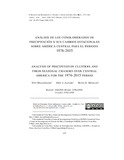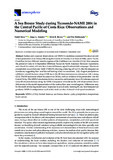Buscar
Mostrando ítems 1-10 de 18
Predicción estacional para ASO de eventos extremos y días con precipitación sobre las vertientes Pacífico y Caribe de América Central, utilizando análisis de correlación canónica
Seasonal prediction of extreme precipitation events, and frequency of rainy days for ASO over the
Pacific and Caribbean slopes of Central America using Canonical Correlation Analysis
Models were generated based on Canonical Correlation Analysis for prediction of extreme precipitation events during August-September-October (ASO), using as predictor the Sea Surface Temperature (SST) due to the hydrological ...
Regional Precipitation Study in Central America, Using the WRF Model
(Examensarbete vid Institutionen för geovetenskaper, pp.1-45, 2012)
Using the regional climate model WRF, and the NCEP-NCAR Reanalysis Project data as boundary and initial conditions, regional precipitation was estimated by means of the dynamical downscaling technique for two selected ...
Examination of WRF-ARW experiments using different planetary boundary layer parameterizations to study the rapid intensification and trajectory of Hurricane Otto 2016
(2020)
Hurricane Otto (2016) was characterised by remarkable meteorological features of relevance for the scientific community and society. Scientifically, among the most important attributes of Otto is that it underwent a rapid ...
The role of the meridional sea surface temperature gradient in controlling the Caribbean low-level jet
(2017)
The Caribbean low‐level jet (CLLJ) is an important modulator of regional climate, especially precipitation, in the Caribbean and Central America. Previous work has inferred, due to their semiannual cycle, an association ...
Propuesta metodológica para la predicción climática estacional de eventos extremos y días con precipitación. Estudio de caso: Sur de América Central
Seasonal climate prediction of extreme precipitation events and frequency of rainy days in the South of Central America as a study case. A methodological proposal.
(2011-11-10)
Se describe una propuesta metodológica en donde se ajustaron modelos estadísticos usando el Análisis de Correlación Canónica para la predicción climática estacional del acumulado de precipitación, los días con precipitación, ...
Análisis de los conglomerados de precipitación y sus cambios estacionales sobre América Central para el período 1976-2015
Analysis of precipitation clusters and their seasonal changes over Central America for the 1976-2015 period
(2021-07-08)
La ubicación geográfica de América Central juega un papel importante en la descripción de la variabilidad climática de la región. Está rodeada por dos grandes masas de agua, el Pacífico Tropical del Este en el lado occidental ...
A review of the main drivers and variability of Central America’s Climate and seasonal forecast systems
Una revisión de los principales controladores y de la variabilidad del clima en América Central y sistemas de pronóstico estacional
(2018-04)
América Central es una región susceptible a desastres naturales y cambio climático. En el presente estudio, se revisaron los principales forzantes atmosféricos y oceánicos, así como los moduladores del clima que afectan ...
A Sea Breeze Study during Ticosonde-NAME 2004 in the Central Pacific of Costa Rica: Observations and Numerical Modeling
(2020)
Surface and upper air observations and MM5v3 simulations examined the structure and
inland penetration of sea breeze (SB) along the Grande de Tárcoles river basin (GTRB), central Pacific,
Costa Rica, for two different ...
Regional precipitation estimations in Central America using the Weather Research and Forecast model
Estimaciones de precipitación regional en América Central usando el model Weather Research and Forecast
(2018-04)
Using the regional climate model WRF, and the NCEP-NCAR Reanalysis Project data as boundary and initial conditions, regional precipitation for Central America was estimated by means of the dynamical downscaling technique ...
On the variability of the Caribbean lowlevel jet during winter: revisited
(Memorias de la European Geosciences Union General Assembly 2014, 2014-04)
The Caribbean low-level jet (CLLJ) is a strong wind current over the Caribbean Sea. Annually it has two peak periods, where February and July being the winter and summer components, respectively. The CLLJ is an important ...











